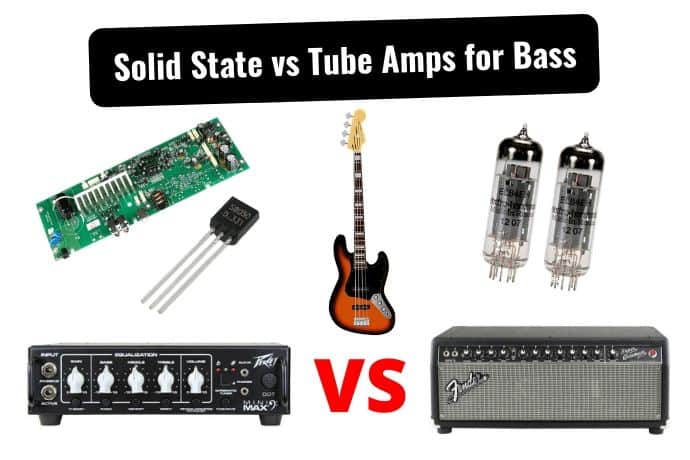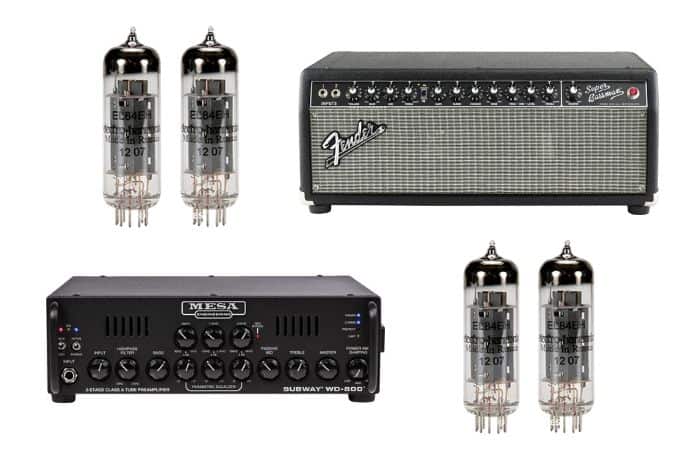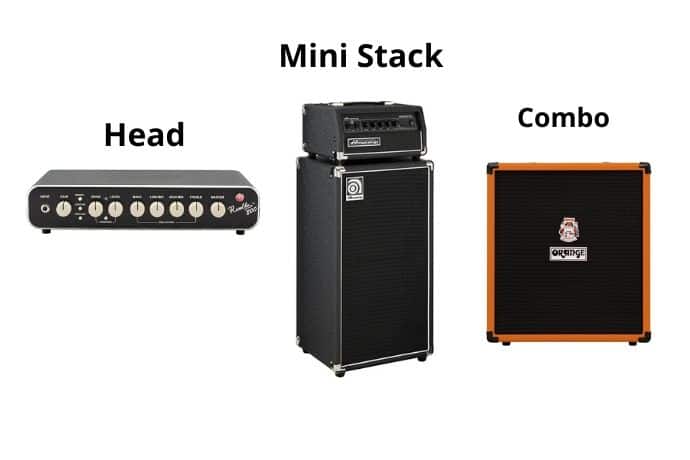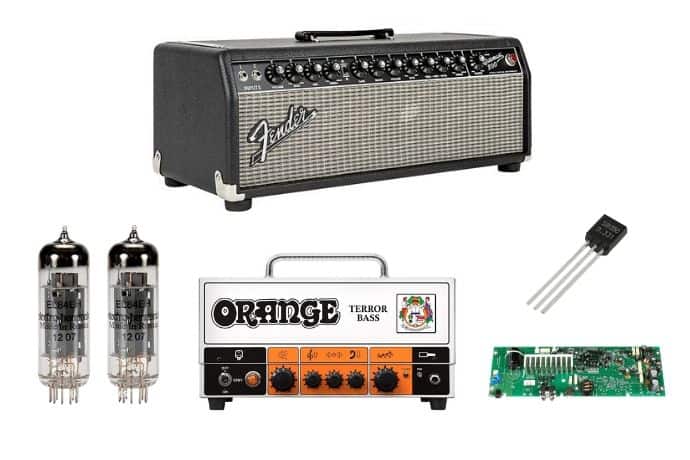
The foundation of any bass tone relies heavily on your choice of amplifier.
And knowing this, players must decide between a reliable workhorse of a solid-state amplifier or the classic sound of a tube amplifier. Which one to choose?
In this post, I will compare everything you need to know about tube and solid-state bass amplifiers.
Explore everything from tone, functionality, price, and much more. This read may assist your decision for your primary weapon of amplification for your bass rig.
Sound good? What are the primary differences between a tube bass amp and a solid-state bass amplifier?
Tube bass amps produce warm, responsive, and organic distortion when driven. However, they are more expensive, less portable, and fragile. In comparison, solid-state bass amps produce a harsher distortion but are more affordable, portable, versatile, and generally louder in comparison to their size.
Comparison Video (Watch Below)
Tube/Valve Bass Amplifiers

Tube bass amplifiers were the powerhouse amp of the 60s and 70s. If you listen to any record during this period, I guarantee you would hear the pristine and authentic sound of a tube amplifier powering the low end of the track.
Back then, tube/valve bass amps were the only option until solid-state technology arrived and gained mass popularity.
Tube amps are still viable and a popular option today due to their pristine sound.
How do they work?
As the name implies, tube/valve amps adopt pre and power vacuum tubes as their amplification engine room.
The first step is when the signal from your guitar pickup reaches the pre-amp stage. The preamp stage prepares the signal by amplifying it a line-level which will eventually drive your speakers.
The preamp stage is where the tonal magic happens. The preamp tubes colors the tones adding sweet distortion and overdrive and other delicious overtones.
This stage is what gives each individual amp their own unique tonal character.
Next, is the power amp section, it receives the signal from the preamp, which then drives the ‘wall of sound’ through your speaker for the delightful volume all guitar players love.
How Do They Sound?
Tube amps are regarded somewhat as ‘the golden egg’ and the ‘pinnacle’ when it comes to bass amp distortion and overdrive.
Tube amp distortion notably sounds organic, warm, and smooth due to the analog nature of the power tubes.
They offer sweet overtones when pushed, providing natural and smooth clipping for authentic and delicious bass tones.
Disadvantages
As amazing as they sound, their drawback is their rather high price tag. Not to mention their heavy and bulky frames, making them a nuisance for transferring to and from locations.
Secondly, their reliability is questionable due to their make-up of fragile components, including their delicate power tubes, which are vulnerable and common to break at inappropriate times during a gig, for example.
Price
A Tube bass amp head (without speaker cabinets) purchased new can costs between $350 – $3500 + depending on the brand.
How often do pre and power tubes need replacing?
- Power tubes need replacing roughly 500 hours of playing time
- Preamp tubes need replacing 1000 hours of playing time
- New power tubes cost roughly $30
- Preamp tubes cost approximately $10
- If the tubes have any cracks or defects, replace them
- If the tubes glow red, then the glass chassis has cracked and need replacing
Pros
- Tone – tubes produce warm and organic distortion when pushed on the limit of ‘break-up’ for pleasing nuances and character.
- Authentic sound – some players argue tube amp overdrive sounds’ natural’ and ‘smooth’ compared to a solid-state amp
- Overtones -tube amps produce significant overtones when they transition to ‘clipping’ (overdrive)
- Volume – tube amps are generally louder when on the same volume as solid-state amps
- Modification – You can swap out different tubes for slight differences in tone, adding your favorite power tubes.
- Aesthetics – tube amps look cool when the tubes are glowing a satisfying illumination.
Cons
- Reliability – Amplifiers adopting tubes as their amplification source are more delicate to breaking as power and preamp tubes are housed in a glass chassis, which are fragile and delicate. You have to be super careful when carrying and transferring them around.
- Reliability x2 – Tube amps need to be warmed up before they can produce their optimal tone and are susceptible to failing in excessively warm and cold environments.
- Reliability x3 – Tubes can break during gigs and not a quick and easy replacement while on stage. Tubes also need to be maintained and replaced over time.
- Portability – Tube amps require a larger chassis meaning they take up more space in transit and more annoying to transfer.
- Weight – Tube amps are generally larger and include heavier components in their chassis. Tubes on their own are on the weighty side.
- Price – Tube amps are significantly more expensive than solid-state amps and less practical for beginners with a smaller budget.
Best for:
- Players who know and love the warm, organic, and’ holy grail’ tone of tube amp distortion and overdrive. These players love it so much, so they must have it in their sound.
- Players who want an old fashioned ‘old school’ tone of the 60s and 70s records before solid-state technology became widespread.
- Players who love the tone so much and not concerned about the drawbacks when it comes to reliability and portability.
- Professional musicians who love the tone, have the money and have roadies to carry their equipment around for them.
Not For:
- Beginners just starting, tube amps are costly, they are not ideal for purchasing as your first or second amp.
- Players who want a reliable amp without breaking mid gig or having to maintain their amp.
- Players requiring a portable amp for transferring easily to practice and gigs.
Solid-State Bass Amplifiers

As Solid-state bass amps emerged during the 60s, their popularity quickly soared, stealing the crown from the tube amplifier within a few decades and still firmly wear that crown today.
Their rise in popularity is down to their affordability, compact size, and reliability compared to the bulky, heavy, and unreliable tube amp.
How do they work?
Solid-state bass amps use transistors and diodes as their way of amplification. Without power tubes and less circuitry, it allows for fewer components within the unit.
Therefore can decrease the size of the amp chassis, allowing them to be portable, super loud, and ultimate gigging amps.
It also vastly increases the reliability of the amp without needing any fragile components such as power tubes.
How do they sound?
Bass players argue that that Solid-state amps sound ‘harsh’ ‘digital’ when pushed into overdrive.
Their clipping characteristics are somewhat ‘fizzy’ and not as authentic as the smooth distortion tone of a tube amp.
On the other hand, some players like this sound, notably the grunge players of the 90s, for an aggressive and distorted tone.
The solid-state tone sound is colorless, which depending on the player, is an advantage or disadvantage.
However, some players like a colorless tone. It all depends on your tastes as the ideal sound is in your head. Bass Tone is subjective after all.
Price
Solid State bass amp heads (without a cabinet) range from $100 – $2000 + (new)
Solid state combos capable of gigging range from $300 – $3000 + (new)
Do tube distortion pedals improve a solid-state amps tone?
Players argue that a solid-state amps distortion can be improved or replaced with a good quality tube-based distortion/overdrive pedal.
This option is a notable way of emulating a more realistic tube amp sound without purchasing a full blow tube amplifier.
Although this seems a good idea, keep in mind, tube distortion pedals will offer more realistic tube amp sound.
However, because the power section of a solid-state is still powered by transistors, it will not replicate the full authentic tone of a tube amplifier.
This all depends on the pedal and amp you are using. With that said, you should experiment with different pedals with your amp to perhaps stumble on a dirt pedal you like and may prefer the sound of compared to your amps drive.
The Future
Solid-state technology continues to improve year by year, meaning that every solid-state amp that hits the market will sound better and more authentic than the last.
And because of this, solid-state amps are undoubted the popular choice for the majority of bass players in today’s world. The future of solid-state amplifiers is very bright indeed!
Pros
- Reliability – Solid-state bass amps adopt transistors as their primary amplification source. Meaning fewer components, and they rarely fail.
- Reliability x2 – Solid-state amps can be knocked, bashed, and will still keep going without ever needing to maintain and replace components.
- Reliability x3 – Solid-state amps work as soon as you turn them on and work flawlessly in any environment, making them the ideal gigging workhorse amp.
- Portability – Solid-state amps have less bulky components meaning they are smaller, allowing to move them around for gigs and practice.
- Weight – Solid state amps are lighter making them easier to carry to gigs and practice
- Price – Solid-state amps are far cheaper than tube amps, making them ideal for beginners and musicians looking to gig on a smaller budget.
- Versatility – These amps generally include more EQ settings, effects, and features, including: inputs, headphones input, and Bluetooth connectivity.
Cons
- Tone – Some bass player purists argue that solid-state amps sound ‘sterile,’ ‘digital,’ and produce less authentic drive tones compared to the organic sound of a tube amplifier.
- Tonal response – Solid-state amps -do not react tonally in comparison to tube amplifiers.
Best for:
- All levels and playing experience: beginners, intermediates, and even professional players love solid-state amps.
- Players who want a compact and powerful amp capable of pumping out a ton of volume for practice and gigs.
- Players who want to purchase an affordable amp who have less money to spend.
- Players who want a trustworthy and reliable workhorse amp that will be ready to play without any worries of breaking and require no maintenance.
- Players who are frequent gigging musicians requiring a lighter and more portable amp for carrying home, rehearsals and gigs.
Hybrid Amplifiers

As a bonus, I can not offer a complete comparison without discussing hybrid amplifiers.
These popular amps are essentially a ‘blend’ of both amplifiers in function, adopting vacuum tubes and transistors to amplify a bass signal.
These amplifiers attempt to offer bass players ‘the best of both worlds.’ Providing realistic tube amp tone with the size, weight, and reliability of a solid-state amp.
This winning combination makes hybrid amps ideal for practice and gigging for the working man musician.
Price
Hybrid bass amp heads (without cabinet) range from $400 – $2000 + (new)
How do they sound?
Hybrid amps blend the color of a tube amp with the power and output of a solid-state amp.
This offers players a versatile amp for players who play a host of genres, making it a solid companion for the jamming and gigging musician.
They are necessarily the perfect compromise between the warmth of a tube amp and the reliability and power of a solid-state amp.
Pros
- Tone – Hybrid amps include preamp vacuum tubes to nicely color the tone providing an organic tube amp sound, considered more authentic compared to a full solid-state amp. The solid-state section within a hybrid can then crank out mass amounts of volume, making them a tremendous functional combination.
- Size – Hybrid amps are much smaller in proportion as they are a slimmed-down version of a tube amp, making them more portable for gigs and practice.
- Weight – Hybrids are much lighter compared to a full tube amp making them easier to transfer and haul around.
- Reliability – Hybrid amps are greatly more reliable than full tube amplifiers and will work well in any environment.
- Versatile – Hybrid amps are mostly for players who cannot decide between the tube and solid-state amps. They cater to the players who want the best of both worlds.
Cons
- Tone – Although hybrids sound more authentic than full solid-state amps, they still do not match a full tube amps warm and organic tone.
- Maintenance – Hybrids will require some maintenance as the vacuum tubes will need replacing over time.
- Pleasing nobody – Some players argue that hybrids do not provide the full tube amp tone experience and do not have the size and portability of a full solid-state amp. Meaning no camp is satisfied. Jack of all trades master of none!
Best For:
- Players who want a good attempt of a tube amps drive and distortion without the size and reliability issues of a full-blown tube amplifier.
- Players who require an affordable amp without breaking the bank
- Players who want the best of both worlds when it comes to amp functionality
- Players who require a versatile and reliable amp with minimal maintenance
Not For:
- Purists who adopt an ‘all or nothing’ approach when it comes to amplifiers.
Do you love playing funky slap bass? Want to know the ‘secrets’ when sculpting a sweet slap bass sound?
Then you must read my post “How to Get a Killer Slap Bass Tone (The Ultimate Guide)”
This article is the definitive guide to EQ settings, technique, bass guitars, strings, set up, and more. For dialing in an optimal bass tone with any amp, guitar, and other gear you own.
Related Questions
Why are bass amps so expensive?
Bass amps can be expensive if they are tube amps. Tube amps use vacuum power tubes to amplify the signal, which is costly on their own. Secondly, tube amps have more components and generally larger in size, requiring more materials to house all the components.
What is bass combo amp?
A bass combo amp is an amplifier, including a bass head and speaker cab combination in one unit. Hence whey they are labelled as a ‘combo amp.’ Combo amps are generally more practical and cheaper than buying a bass head and speaker cabinet separately.
Do you need an amp to play bass?
Yes, you can play bass without an amp. However, electric bass guitars have little to no acoustic projection. For this reason, you should connect your bass to an amplifier to listen to what you are playing to hear the low frequencies of your bass guitar.
Thanks for Reading
Speaking of amplifiers! Want to know some of the best amp simulator software for an infinite amount of customizable bass tones for recording and jamming on your PC?
If the answer is hell yes!
Then you should read my next awesome post. “The 7 Best Amp simulators for bass” This post outlines the current best bass amp simulators on today’s market for recording bass direct to any recording software.


